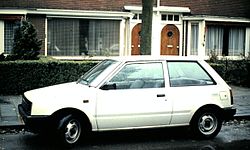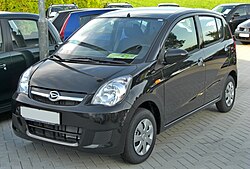Daihatsu Charade
| Daihatsu Charade | |
|---|---|
| Production period: | 1977–2000 since 2003 |
| Class : | Small car |
| Body versions : | Limousine , station wagon |
| Successor: | Daihatsu Sirion |
The Daihatsu Charade is a passenger car model produced by the Japanese manufacturer Daihatsu since 1977 (export to Europe from 1978) . A special feature of the Charade was that it was positioned exactly between the class of small cars and compact cars. In 2000 the model series was temporarily discontinued, and in 2003 it was finally revived in some markets as a sister model to the Daihatsu Cuore .
The first generation, which was named “Car of the Year” in Japan in 1977, rolled off the assembly line from 1978 to 1983 as a three- and five-door hatchback sedan. A special feature of the three-door was an opera window in the C-pillar, which was otherwise only found in American hard-tops. This was followed by a clearly angular successor.
In 1987 the third generation of the Charade was presented, which was now also available as a four-door notchback sedan. This model is produced by the Xiali brand in China as part of a joint venture . The models that appeared there are still very successful today. So far, three generations of Xiali have been established as a direct sister model, and another only as an optical offshoot.
The Charade GTti, the sportiest offshoot of the series, deserves special attention. With the help of an exhaust gas turbocharger, it generates an output of 74 kW (101 hp) from a three-cylinder 12-valve gasoline engine with a displacement of 993 cm³. Thanks to the low curb weight of 810 kg, an acceleration of 0-100 km / h in 8.1 s is possible. Due to its robustness and simple technology, the Charade GTti has often been used successfully in motorsport.
Another model change took place in 1994. Due to the sharp drop in sales of the Charade, this series was replaced in 1997 by the Daihatsu Sirion . Nevertheless, the hatchback and shortback (notchback) variants of the Charade were offered in parallel with the Sirion until 2000.
In Great Britain and the markets of a few other countries, the Daihatsu Cuore has been sold as Daihatsu Charade since 2003. In 2008, the next generation of Cuore took over in South Africa.
Between May 2011 and January 2013 the Daihatsu Charade was sold again in Germany. Unlike the English model, it is a replica of the second generation Toyota Yaris .
The generations at a glance
Daihatsu Charade
Generation G10
1977–1983Daihatsu Charade
Generation G11
1983–1987Daihatsu Charade
Generation G100 / G102
1987–1994Daihatsu Charade
Generation G200 / G203
1994-2000Daihatsu Charade Centro
Generation L500
1995-1998Daihatsu Charade
Generation L251
2003-2011Daihatsu Charade
Generation L276
since 2008Daihatsu Charade
Generation XP9
2011-2013
First generation G10 (1977–1983)
| Charade (G10) | |
|---|---|
| Production period: | 1977-1983 |
| Body versions : | Station wagon |
| Engines: |
Otto engine : 1.0 liter (37 kW) |
| Length: | 3575 mm |
| Width: | 1520 mm |
| Height: | 1345 mm |
| Wheelbase : | 2300 mm |
| Empty weight : | 680-690 kg |
Second generation G11 (1983–1987)
| Charade (G11) | |
|---|---|
| Production period: | 1983-1987 |
| Body versions : | Station wagon |
| Engines: |
Otto engine : 1.0 liter (37–50 kW) Diesel engine : 1.0 liter (27 kW) |
| Length: | 3550 mm |
| Width: | 1550 mm |
| Height: | 1395-1430 mm |
| Wheelbase : | 2320 mm |
| Empty weight : | 665-695 kg |
The G11 model was slightly larger than its predecessor and adapted to the zeitgeist. The basis remained the 3-cylinder engine with 37 kW (52 PS). The model was available with two doors and four doors. Extensively equipped for this time, for example with a partially foldable backrest, rev counter and warning sound for switched on lights. The vehicle had exhaust gas recirculation and was allowed to drive in smog level 1 in Berlin, for example. There was also a diesel engine with an output of 27 kW. The Daihatsu Charade was one of the cheapest diesels on the market. A 50 kW machine rounded off the offer. With this engine the Charade drove 170 km / h.
- Construction period: October 1983 to March 1987
Third generation G100 / G102 (1987–1994)
| Charade (G100) | |
|---|---|
| Production period: | 1987-1994 |
| Body versions : | Station wagon |
| Engines: |
Otto engines : 1.0-1.3 liters |
| Length: | 3680 mm |
| Width: | 1615 mm |
| Height: | 1385 mm |
| Wheelbase : | 2340 mm |
| Empty weight : | 760-825 kg |
The Charade was also available as a special model in Europe as the 101 PS GTti Sport. 2500 units of this model were delivered so that homologation for rally sport was possible. With a liter output of over 100 hp / l, the Charade GTti Sport was the record holder for series vehicles in this area at the time.
Fourth generation G200 / G203 (1993–2000)
| Charade (G200) | |
|---|---|
|
Charade G200 (1993-1996) |
|
| Production period: | 1993-2000 |
| Body versions : | Limousine , station wagon |
| Engines: |
Petrol engines : 1.3-1.6 liters (44-77 kW) |
| Length: | 3750-4085 mm |
| Width: | 1620 mm |
| Height: | 1390 mm |
| Wheelbase : | 2395 mm |
| Empty weight : | 830-905 kg |
- Engines:
- 1.3 l (44-77 kW)
- 1.5 l (55-66 kW)
- 1.6 l (77 kW)
Fifth generation L500 (1995–1998)
| Charade (L500) | |
|---|---|
| Production period: | 1995-1998 |
| Body versions : | Station wagon |
| Engines: |
Otto engine : 0.7 liters (31 kW) |
| Length: | 3310 mm |
| Width: | 1395 mm |
| Height: | 1440 mm |
| Wheelbase : | |
| Empty weight : | 660 kg |
Sixth generation L251 (2003-2011)
| Charade (L251) | |
|---|---|
| Production period: | 2003-2011 |
| Body versions : | Station wagon |
| Engines: |
Otto engine : 1.0 liter (40.5 kW) |
| Length: | 3400 mm |
| Width: | 1475 mm |
| Height: | 1500 mm |
| Wheelbase : | |
| Empty weight : | |
Seventh generation L276 (since 2008)
| Charade (L276) | |
|---|---|
| Production period: | since 2008 |
| Body versions : | Station wagon |
| Engines: |
Otto engine : 1.0 liter (51 kW) |
| Length: | 3470 mm |
| Width: | 1475 mm |
| Height: | 1530 mm |
| Wheelbase : | 2490 mm |
| Empty weight : | 765-775 kg |
Eighth generation XP9 (2011-2013)
| Charade (XP9) | |
|---|---|
| Production period: | 2011-2013 |
| Body versions : | Limousine , station wagon |
| Engines: |
Otto engine : 1.33 liters (73 kW) |
| Length: | 3785 mm |
| Width: | 1695 mm |
| Height: | 1530 mm |
| Wheelbase : | 2460 mm |
| Empty weight : | 1115-1125 kg |
Web links
Individual evidence
- ↑ Daihatsu Charade G11
- ↑ Bosch product finder, windshield wipers 1999/2000 (Danish and Norwegian)


















